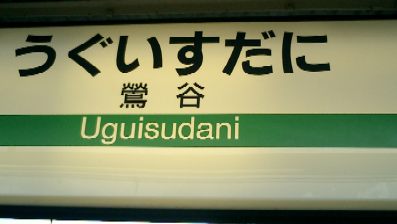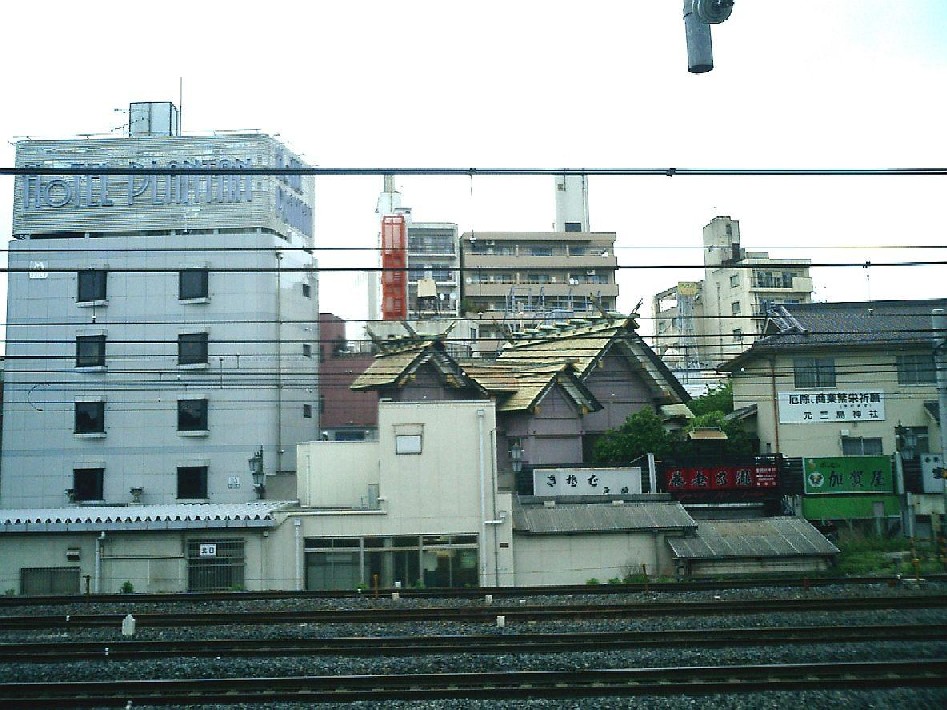

Uguisudani Station
The Neighbourhood - A View from the Platform
A Visit to "Nishinomiya Woodblock Print Shop" (or "Nishinomiya Hangaten")
(Information from interviews conducted by Andreas Grund; Tokyo, June 2004 and earlier.)
"Valley of the Nightingale," or in Japanese, Uguisudani, that is the name of the nearest train station to the "Nishinomiya Woodblock Print Shop" (or "Nishinomiya Hangaten") in a northern Tokyo suburb. Many of our readers will instantly recognize the name "Nishinomiya" as being the publisher of the quintessential 21 "chuban" format (7 x 10 inch) print series know as "The Night Scenes" (originally published ca1910-20), and the 10 "oban" designs by Ito Yuhan (believed to be designed in the 1930's), whose "soft print style" evokes the romantic beauty of Japan's unspoiled past. Sadly, the nightingales in this busy place now are gone for decades. However, you can listen to their songs as a playback from the platform's speakers, provided, it is not overtoned by the noisy karasu (crows) from nearby Ueno Park.
|
|
|
|
Uguisudani Station |
The Neighbourhood - A View from the Platform |
The Nishinomiya estate still exists, and is actually a compound of substantial size, comprised of several buildings, new ones, and older ones. Especially one of the buildings looks completely strange is this neighborhood, it seems like being transferred from old Europe to Tokyo. Although aged now and in a condition which is far from its glorious past, it still shows a certain charm. A metal mailbox just in front confirmed that we reached our destination - Nishinomiya Hangaten, to be translated best as "Nishinomiya Woodblock Print Shop."
|
|
|
|
The old Victorian Nishinomiya House, left the new house |
The Mailbox: upper Nishinomiya Hangaten, lower Nishinomiya Yusaku |
Here then, I got the chance to meet on several occasions with Mr. Nishinomiya Yusaku, born 1932 as the son of Nishinomiya Yosaku (1896-1986). He was cheerful and of a pleasant personality, and I hardly could believe his age. Communication with him is easy, he speaks English very well. We always met in the "old house", which the Nishinomiya family acquired around 1920 from the famous Mutsu Minemitsu family. Mr. Minemitsu once was a foreign minister during the Meiji Era (1868-1912 period). This older Victorian-style house was not used for living.
|
|
|
|
Inside the "old" house |
A carved plate |
Although used previously as the studio for carving and printing, now this old house is used merely a warehouse, although the remaining woodblocks are kept in a separate storage under temperature and humidity control to keep them in "good shape." In the past years, around this location all kinds of art supplies were available, paper, brushes, and pigments due to being in the vicinity of the many art museums in Ueno. The carved wooden plate shown above right reads "Nihon Mokuhan Kogyo Kyokai,", which means "Member of the Japanese Woodblock Print Industry Assocation."
|
|
|
|
Nishinomiya Yusaku |
Reading a letter from Robert O. Muller |
Nishinomiya Yusaku - his firstname is almost identical to his father's "Yosaku" -and his son Kensaku, born 1977, continue the publishing business on small scale to this day, but complain the lack of good artists and artisans, especially printers, nowadays. He remembers well many old artisans of the print business, for example printer Yokoi, who was Seki's uncle and lived in nearby Iidabashi. The strongest pillar of the business was always the export of prints to the USA. An insurance document of 1986 (which by chance I happened to see) stated the shipping of 290 prints in one shipment to a dealer in San Francisco in 1986. On one of my visits I was glad to accept as a gift an old Hasegawa catalogue, showing the complete range of books and prints for sale. This catalogue, however, does not include any prints by either Koson or Ito Yuhan. As explained by Mr. Nishinomiya, this catalogue was published around 1930, which explains the above missing artists.
In the mid-thirties Nishinomiya bought ten complete sets of woodblocks of Koson prints from Daihei(?) =Daikokuya(?) and published them pre-War, bearing the seal "Nishinomiya" on one of their margins. Only a very few of these old prints remained still in-stock, all of which were obtained to be made available for the customers of Ukiyoe-Gallery.com.
The "Night Scenes" Series (21 Print Designs)
The wonderfully evocative blue "Night Scenes" are certainly an integral part of the shin-hanga movement and
are among the most famous prints published by Nishinomiya. Published since the
early 1920's, in various shades of blue, gray and sepia, the best selling of these
designs got reprinted again and again, on average one batch in two years. The
"block sets" are still the original blocks, however, it is very likely that some of the worn or damaged
blocks got recarved over the time.
According to Yasaku, the last reported reprinting session was done around
1996; these "newer" prints can be easily recognized by the bright paper with
wide, straight-cut margins. Nishinomiya confirmed however that he does not intend to reprint
again! With no more "later" prints left in stock, these too will soon become rare. For further information, especially the "early years"
of Hasegawa / Nishinomiya and about the "Night Scenes," see the relevant articles at our good friend Marc
Kahn's Shotei.com website. Be sure to also visit our just-completed
Ukiyoe-Gallery article "The 'Night Scenes'
by Hasegawa/Nishinomiya Publisher."
|
|
|
|
The remaining few "Night Scenes" inventory |
The early Showa Catalogue, left; and a bi-colored woodblock from an unknown artist, right |
Ito Yuhan (1882 to 1951)
Perhaps most surprisingly, I was able to learn that all prints by Ito Yuhan are post-War, made around 1950!! Kuga Denkichi carved these various block-sets, which still exist and were used for occasional reprints until approximately 1990. The then later printer (for later posthumous editions) was a printer named Watanabe (not Eji Watanabe). These posthumous prints are also characterized typically by the use of newer paper and wide, cut margins.
|
|
|
|
|
Some Ito Yuhan Prints |
Yuhan, I was able to learn, was very demanding as an artist--often he mixed the pigments for the printing process by himself, while supervising the printing personally. The earliest print designs of Yuhan included the incorporation of the typical black "key-block" for the outlines and details, whereas his later prints are known for their "soft, almost pastel-like" appearance, thusly imparting the look of hand-painted watercolor prints. However, interestingly I learned, even for these "soft" prints a "key-block" still existed, as it was essential for the registration and preparation of the many various individual color blocks. It simply was NOT imprinted later during the final printing. To learn more about how a print's "key-block" is needed to accurately produce the many other blocks required to produce a given print, see our website's January 2002 article titled ""Hanshita," or Black Ink "Key-block" Outlines."
|
|
|
|
|
Early Yuhan print with black "key-block" |
Later design, without use of a "key- block" |
The seal: Hanken shoyu (upper), Nishinomiya Yosaku |
As with the "Night Scene" prints mentioned earlier, we were also able to purchase the remaining stock of Ito Yuhan's prints for Ukiyoe-Gallery.
Robert O. Muller's Ties to the Nishinomiya Family
|
|
As I was able to learn, Yusaku knew Robert Muller and his wife Inge very well. Bob had visited them three times in Tokyo, the last time, accompanied by his daughter Trudy, in May 1986, after a break of 23 years. Sometimes, Bob stayed overnight at the Nishinomiya family, but not in the old Victorian house. We talked about Bob Muller, his famous collection and the business story of Shima Art Company and the Robert Lee Gallery. Mr. Nishinomiya remembered, that occasionally he was asked to obtain Hasui prints from Doi Publisher for Bob Muller. Yusaku showed me some correspondence between Bob and himself, of which we are glad to display their content here, giving us deep insights of the sensitive and caring character of Robert Muller and his warm relationship with the Nishinomiya family. In return I gave him a set of printed copies from Marc Kahn's articles at his wonderful Shotei.com website about Robert Muller. Robert Muller already bought prints before the War from Nishinomiya. |
|
A handwritten letter by Robert Muller |
|
Following immediately below are the transcripts of three letters between Robert Muller and Yusaku Nishinomiya. The handwritten letter above is shown last.
Letters between Robert Muller and the Nishinomiya Family
|
Mr. Yusaku Nishinomiya, Tokyo February 28, 1986
Dear Nishinomiya-San, This winter, as all our winters, has been very cold. Every evening I take a hot bath, soaking up the wonderful heat; and then I think back to when I came to Japan twenty-three years ago, in February, and your father invited me to your home, and every evening I took a hot bath to prepare me for the cozy futon. I felt most privileged to be included in the warmth of your family life, and it is one of the happy memories of my life. And now I am making plans for another visit to Japan, and I look forward to seeing you once more. This time one of my daughters has said she will not be left out. The two of us will be arriving May 17th, staying at the Hilltop Hotel. As usual the stay will be much too short, for we will be also going to Kyoto and further. How is your family? Growing fast, I am sure. Kensaku must be about ten years old now. Are you still living in Gamo? And your parents? The years go by so fast, and I am afraid to ask. Last year you wrote explaining about the Hasegawa artists. I understand that these facts of the past are not always easy to find. All my best to your good wife. Sincerely Robert M. |
|
Mr. Robert O. Muller May 7, 1986 Merwin's Art Shop New Haven Conn. U.S.A.
Dear Mr. Muller, I am wondering if this letter reaches you before you leave your place. At any rate, we look forward seeing you soon, although we have some story which we have to tell you. Sincerely yours, Y. Nishinomiya Via Air Mail |
|
Robert O. Muller
Dear Nishinomiya-San, It was good to see you and Takeshi one more in your old home and to catch up on family news, even though I was saddened to hear that your father is no longer with us. He was a fine gentleman for whom I had much respect, and he helped me much with my knowledge and collecting of Japanese prints. An he was very patient with my ignorance about many things. Also I am sorry that Trudy and I have such a busy and short visit, for we would have liked to see your family, Tamiko and the children - giving Kensaku an opportunity to practice his English! The present high rate of the yen, or rather the collapse of the dollar will have a big influence on the Japanese print market in the U.S.A. All my best to your good wife, also from Trudy. Sincerely, Robert M. 5/21/86 If there is anything I can do for you in America be sure to let me know - |
Closing Thoughts....
Yusaku Nishinomiya is for me one of the very few remaining symbols of the shin-hanga movement. Whenever I am able to find the occasion to visit with him, I always feel welcome and apparently Mr. Nishinomiya is also made happy, having found someone he too can talk to passionately about woodblock prints. Definitely I want to visit him again!!
© Andreas Grund and Thomas Crossland, June 2004